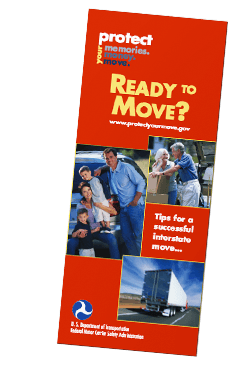Make sure you have the information you need to move confidently.
1) Know your rights and responsibilities before selecting a mover.
Before moving your household goods interstate, movers are required to give you the booklet entitled Your Rights and Responsibilities When You Move. This booklet will help you understand the documents that a mover will ask you to sign, and explains your rights if your household goods are lost or damaged. Movers are also required to give you FMCSA’s Ready to Move brochure, which helps you prepare to move with confidence.

Download the Ready to Move Brochure
Movers are required to provide you with a copy of the Ready to Move brochure. Download this important resource to prepare for a smooth move.
2) Learn to spot the red flags of moving fraud.
Don't know what the red flags are? Check out our educational video and handy list of red flags.
3) Be sure your mover is registered with FMCSA.
And check for insurance and any complaint records – by searching our database of registered movers, or calling FMCSA at (202) 366-9805 for licensing and (202) 385-2423 for insurance.
All interstate household goods movers must be registered with the Federal government. Make sure the mover you select has been assigned a U.S. DOT number, is registered with FMCSA to engage in interstate transportation of household goods, and has the proper level of insurance. Avoid movers that do not show U.S. DOT numbers and brokers that do not show Motor Carrier (MC) numbers in their advertisements.
Be informed and aware of your options when selecting a reputable mover. While most household moves go smoothly, there are dishonest or "rogue" movers you should be aware of.
4) Read and understand all information provided by the mover.
The mover should provide you with the following basic written documents as part of your move:
| Document | Description |
|---|---|
Estimate | The estimate should clearly describe, in writing, all charges for services the mover will perform. Make sure the estimate is signed by the mover. Do not accept verbal estimates. |
Order for Service | The order for service is a list of all the services the mover will perform and shows the dates your household goods will be picked up and delivered. |
Bill of Lading | The bill of lading is a contract between you and the mover and a receipt of your belongings. You should be given a partially completed copy of the bill of lading before the mover leaves the residence at origin. |
Inventory List | The inventory is the receipt showing each item you shipped and its condition. Be sure you receive a written copy of the inventory after your household goods are loaded, and that you agree with its description of your household goods' condition. |
5) Do NOT sign blank or incomplete documents.
6) Make sure you understand the type of liability you agree to.
This is a common pitfall for consumers. Ask yourself if 60 cents per pound is enough coverage for all your household goods if the unexpected happens. Your mover must offer you the option of Full Value Protection, which will provide you with the replacement value of lost or damaged goods. You may also purchase insurance from a third-party insurance company. Before purchasing third-party insurance, check your homeowner’s insurance policy to see if you’re already covered.
7) Supervise the process.
Supervise the loading and unloading of your household goods. If you are not available, appoint a representative to act on your behalf.
8) Use our free tools.
Download our Moving Fraud Prevention Guide and Moving Checklist to use as you plan your move, on moving day and on delivery day.


